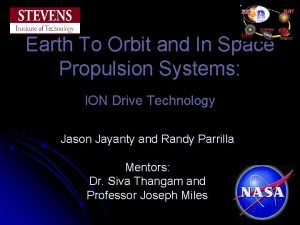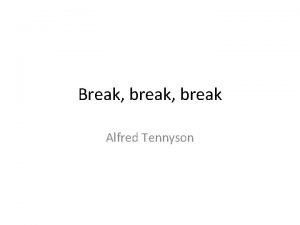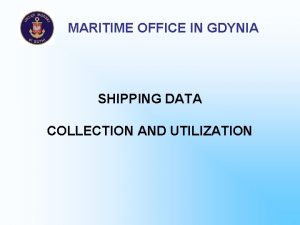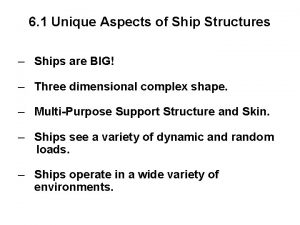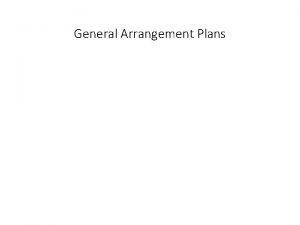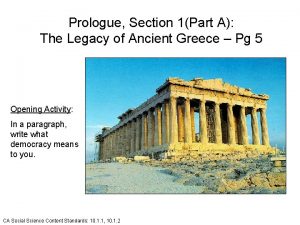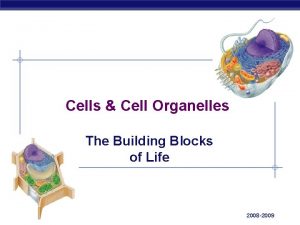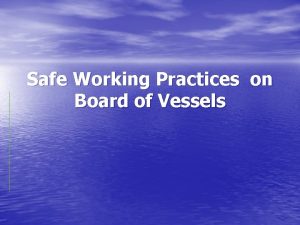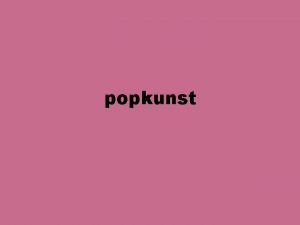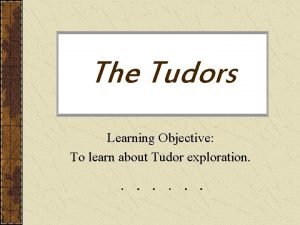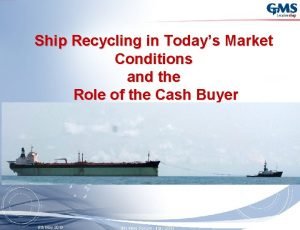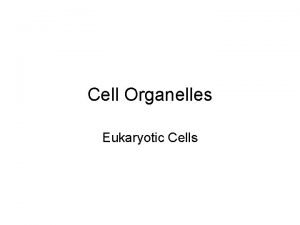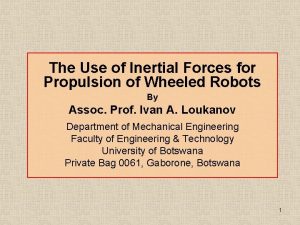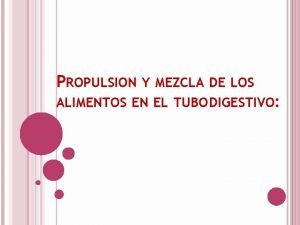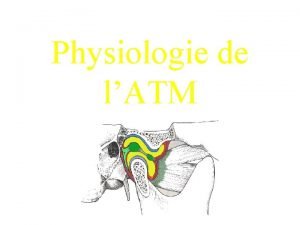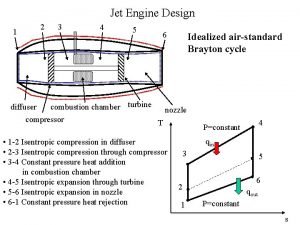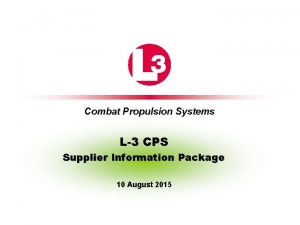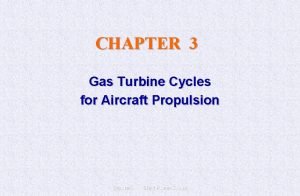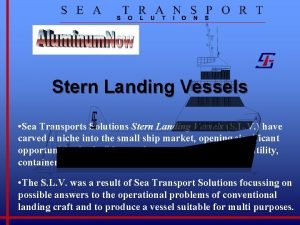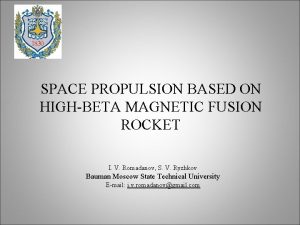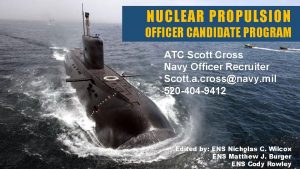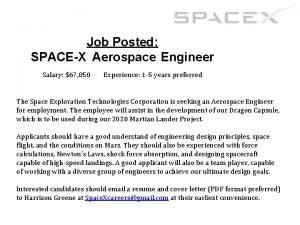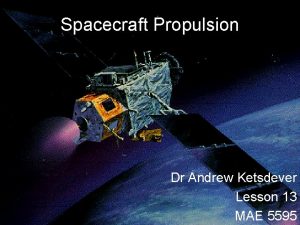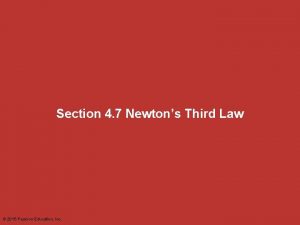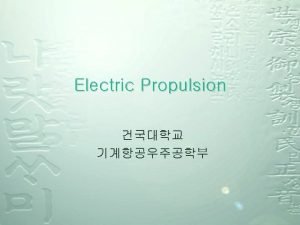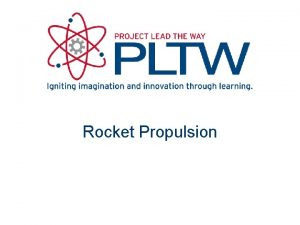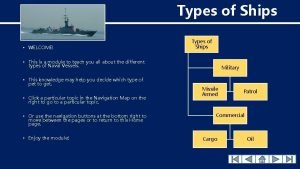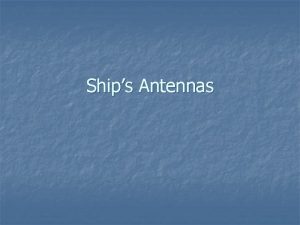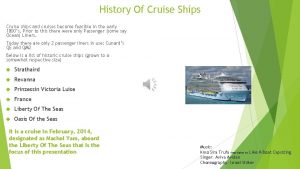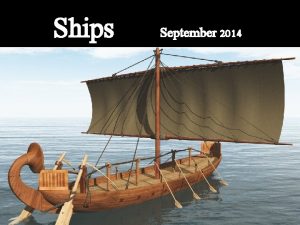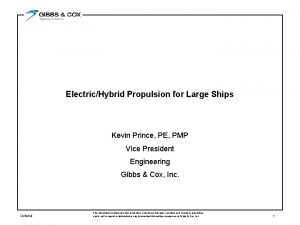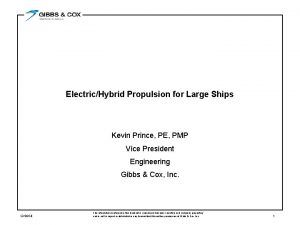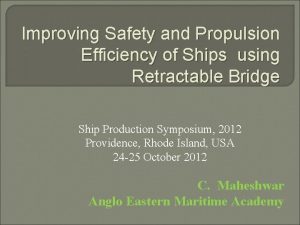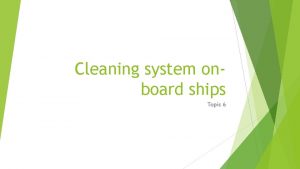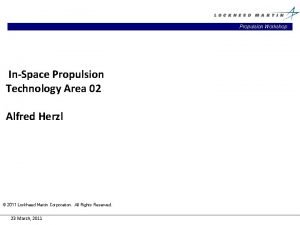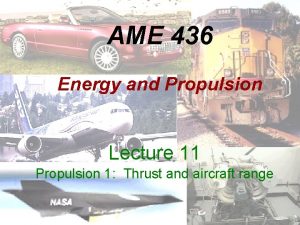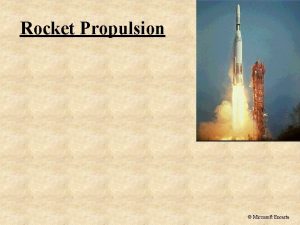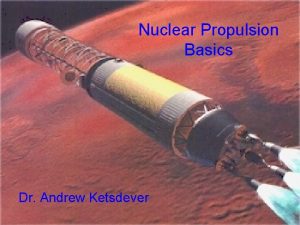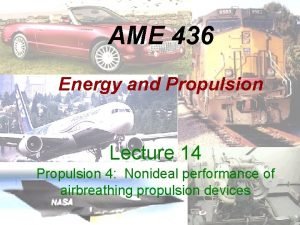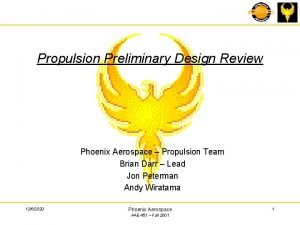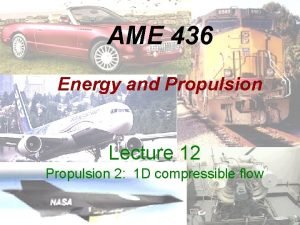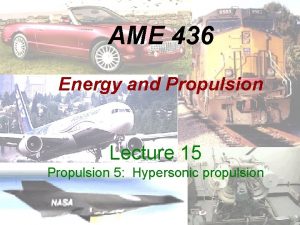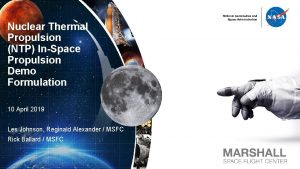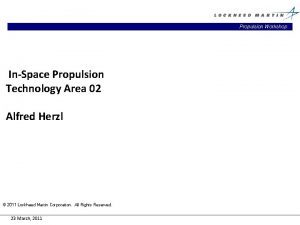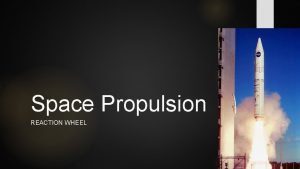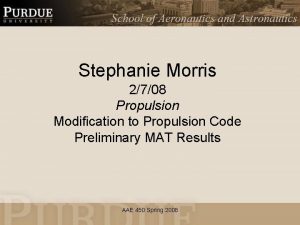Chapter VI Propulsion of Ships The propulsion system














































- Slides: 46

Chapter VI. Propulsion of Ships The propulsion system of a ship is to provide thrust to the ship to overcome the resistance.

6. 1 Introduction • Propulsive Devices (reading p 205 -209) Paddle-Wheels: While the draft varying with ship displacement, the immersion of wheels also varies. The wheels may come out of water when the ship is rolling, causing erratic course-keeping, & they are likely to damage from rough seas. Propellers: Its first use was in a steam-driven boat at N. Y. in 1804. Advantages over paddle-wheels are, 1) not substantially affected by normal changes in draft; 2) not easily damaged; 3) decreasing the width of the ship, & 4) good efficiency driven by lighter engine. Since then, propellers have dominated in use of marine propulsion.

Paddle Wheels Propulsion (Stern)

Paddle Wheels Propulsion (Midship)

Propeller (5 -blade)

Propeller (5 -blade) & Rudder

Jet type: Water is drawn by a pump & delivered sternwards as a jet at a high velocity. The reaction providing the thrust. It’s use has been restricted to special types of ships. Other propulsion Devices: 1. Nozzles (Duct) Propellers: main purpose is to increase thrust at low ship speed (tug, large oil tanker) 2. Vertical-Axis Propellers: Advantage is to control the direction of thrust. Therefore, the ship has good maneuverability. 3. Controllable-Pitch Propellers (CCP): The pitch of screw can be changed so that it will satisfy all working conditions. 4. Tandem and Contra-rotating Propellers: It is used because the diameter of a propeller is restricted due to limit of the draft or other reasons (torpedo). The efficiency of the propeller usually decreases.

Jet Propulsion

Nozzle Propellers

Vertical-Axis Propellers

Vertical-Axis Propellers

Controllable Pitch Propellers (CPP)

Contra-rotating Propellers

• Type of Ship Machinery 1. Steam Engine (no longer used in common) Advantages: 1) good controllability at all loads, 2) to be reversed easily, & 3) rpm (rotations per minute) matches that of propellers Disadvantages: 1. ) very heavy 2. ) occupy more space 3. ) the output of power per cylinder is limited 4. ) fuel consumption is high 2. Steam Turbine Advantages: 1. ) deliver a uniform turning torque, good performance for large unit power output, 2. ) thermal efficiency is high. Disadvantages: 1. ) is nonreversible; 2. ) rpm is too high, need a gear box to reduce its rotating speed

3. Internal combustion engines (Diesel engine) Advantages: 1. ) are built in all sizes, fitted in ships ranging from small boats to large super tankers, (less 100 hp ~ >30, 000 hp); 2. ) High thermal efficiency. Disadvantages: 1. ) Heavy cf. gas turbines; 4. Gas Turbines (developed for aeronautical applications) Advantages: 1. ) Do not need boiler, very light; 2. ) Offer continuous smooth driving, & need very short “warm” time. Disadvantages: 1. ) expensive in cost and maintenance 2. ) need a gear unit to reduce rpm. 5. Nuclear reactors – turbine Advantages 1. ) do not need boiler, fuel weight is very small 2. ) operate full load for very long time (submarine) Disadvantages 1. ) weight of reactor and protection shield are heavy; 2) Environment problem, potential pollution.

• Definition of Power Indicated horsepower (PI): is measured in the cylinders (Steam reciprocating engines) by means of an instrument (an “indicator”) which continuously records the gas or steam pressure throughout the length of the piston travel. pm - mean effective pressure (psi) L – Length of piston stroke (ft) n – number of working strokes per second A – effective piston area (in 2) n – number of cylinders

Brake Horsepower (PB): is the power measured at the crankshaft coupling by means of a mechanical hydraulic or electrical brake. where Q – brake torque (lb-ft) & n – revolutions per second. Shaft horsepower (PS): is the power transmitted through the shaft to the propeller. It is usually measured aboard ship as close to the propeller as possible by means of a torsion meter. where d. S – shaft diameter (in), G – shear modulus of elasticity of shaft material (psi), θ – measured angle of twist (degree), LS – length of shaft over which θ is measured & n – revolution per second

Delivered horsepower (PD): the power delivered to the propeller. Thrust horsepower (PT): T – Thrust delivered by propeller (lb) VA – advance velocity of propeller (ft/s) Effective horsepower (PE , or EHP): RT – total resistance (lb) Vs – advance velocity of ship (ft/s)

• Propulsion Efficiency Total propulsion efficiency

6. 2 Propeller Geometry and Terminology Face Back Hubcap Boss Number of Blades: 2, 3, 4, 5 , 6 Boss Hubcap Shaft

• The face surface of a blade is a portion of a holicoidal surface • The helicoidal surface: Considering a line AB perpendicular to a line AA’ and supposing that AB rotates with uniform velocity about AA’ and at the same time moves along AA’ with uniform velocity, the surface swept out by AB is a helicoidal surface.

Pitch: P when the line AB makes one complete revolution and arrives at A’B’. It traveled an axial distance AA’, which represents the pitch of the surface. The propeller blade is part of that surface and the pitch is also called the pitch of the blade. Pitch angle A P o

p 180


Expended Area AE Developed Area AD

Boss: (aka, Hub) Boss diameter – The blades at their lower ends or roots are attached to a boss which in turn is attached to the propeller shaft. The maximum diameter of this boss is called the boss diameter. The boss diameter is usually made as small as possible and should be no larger than the size sufficient to accommodate the blades and satisfying the requirement of strength. It is usually expressed as a fraction of the propeller diameter. At one time propeller blades were manufactured separately from the boss, but modern fixed pitch propellers have the boss and blades cast together. However, in controllable pitch propellers it is of course necessary for blades and boss to be manufactured separately.

• Blade outline: it is decided by propeller series diagrams. • “Expanded blade outline” • Blade sections: they are radial sections through the blade. The shape of these sections is then shaped when laid out flat. • Blade thickness • Blade width (Chord) • Leading edge • Trailing edge P 181 figure 10. 5

• Rake (a blade is perpendicular or titled w. r. t the boss ) • Skew (the skewness of a blade w. r. t. the center line) • Pitch ratio In case that the pitch, P, is not constant, then the pitch is defined as P = Ptip (the pitch at the tip of a propeller). • Blade area ratio = AD /A 0 AD - Total (developed) blade area clear of that of the boss

6. 3 Theory of Propeller Action • Assumptions: 1) replacing the propeller with a stationary actuating disk across which the pressure is made to rise; 2) neglecting the rotational effect of propeller 3) neglecting vortices shed from the blade tip, & frictional loss. VA D VA(1+a) VA(1+b)


• Momentum Conservation Force = net momentum flux (horizontal) • Energy Equation


• Extension of momentum theory Consider the rotation of the flow passing through the propeller disc. , the reduced ideal efficiency becomes,

• Blade Element Theory In the momentum conservation of a propeller, no detailed information can be obtained with regard to the effects of the blade section shape on propeller thrust and efficiency.

a & a’ are determined by experiments a. VA α α’

6. 4 Similarity Law for Propellers Although theoretical studies and CFD on propellers are very important and provides valuable guideline for designing propeller, a great deal of knowledge concerning the performance of propellers has been obtained from propeller model tests. Hence, it is necessary to examine the relation between model and full-scale results as the case of resistance. In open water (not behind a ship),





6. 5 Propeller Model Test A test on a model propeller is run either in a towing tank or a running flow in a water tunnel (cavitation tunnel) without a model hull in front of it, which is called “open water” tests. 1) VA – velo. of flow 2. ) n - rotation of motor 3. ) po - pressure can be controlled Measure VA , Q, T, and n.

Development of cavitations of a propeller in a cavitation tunnel



Testing results KQ KT

Purpose of open-water tests • It is usually to carry out open water tests on standard series of propellers. Their features (such as # of blades, blade outline shape, blade area ratio, blade section shape, blade thickness fraction, boss diameter & pitch-diameter ratio) are systematically varied. The result data are summarized in a set of particular diagrams, which can be used for design purposes. We will study how to use these diagrams later for designing a propeller. • Studying the efficiency of a propeller and find a propeller with better efficiency • Studying the extent and development of cavitations over a propeller.
 Satellite propulsion system
Satellite propulsion system Fantail ship
Fantail ship Break break break tennyson analysis
Break break break tennyson analysis Maritime office in gdynia
Maritime office in gdynia Elements of ships structure
Elements of ships structure General arrangement plan of a ship
General arrangement plan of a ship Gyroscopic couple definition
Gyroscopic couple definition Xerxes bridge of ships
Xerxes bridge of ships Ribosome factory part or worker
Ribosome factory part or worker How many liberty ships were built
How many liberty ships were built Safe working practices on board ships
Safe working practices on board ships Interjr
Interjr Tudor exploration
Tudor exploration Cash buyer of ships for recycling
Cash buyer of ships for recycling What is the smallest living unit
What is the smallest living unit Microfilament function
Microfilament function Inertial propulsion drive
Inertial propulsion drive Propulsión en el sistema digestivo
Propulsión en el sistema digestivo Condyle orbitant
Condyle orbitant Propulsion efficiency
Propulsion efficiency Cps supplier
Cps supplier Turbojet vs turbofan
Turbojet vs turbofan Sea transport solutions stern landing vessel
Sea transport solutions stern landing vessel Vasimr
Vasimr Nupoc salary
Nupoc salary Aerospace propulsion salary
Aerospace propulsion salary Nuclear propulsion
Nuclear propulsion Andrew ketsdever
Andrew ketsdever Nuclear thermal propulsion
Nuclear thermal propulsion Squid use jet propulsion for rapid escapes
Squid use jet propulsion for rapid escapes Hình ảnh bộ gõ cơ thể búng tay
Hình ảnh bộ gõ cơ thể búng tay Lp html
Lp html Bổ thể
Bổ thể Tỉ lệ cơ thể trẻ em
Tỉ lệ cơ thể trẻ em Gấu đi như thế nào
Gấu đi như thế nào Glasgow thang điểm
Glasgow thang điểm Hát lên người ơi
Hát lên người ơi Các môn thể thao bắt đầu bằng từ đua
Các môn thể thao bắt đầu bằng từ đua Thế nào là hệ số cao nhất
Thế nào là hệ số cao nhất Các châu lục và đại dương trên thế giới
Các châu lục và đại dương trên thế giới Công thức tính độ biến thiên đông lượng
Công thức tính độ biến thiên đông lượng Trời xanh đây là của chúng ta thể thơ
Trời xanh đây là của chúng ta thể thơ Mật thư tọa độ 5x5
Mật thư tọa độ 5x5 Phép trừ bù
Phép trừ bù độ dài liên kết
độ dài liên kết Các châu lục và đại dương trên thế giới
Các châu lục và đại dương trên thế giới Thơ thất ngôn tứ tuyệt đường luật
Thơ thất ngôn tứ tuyệt đường luật
